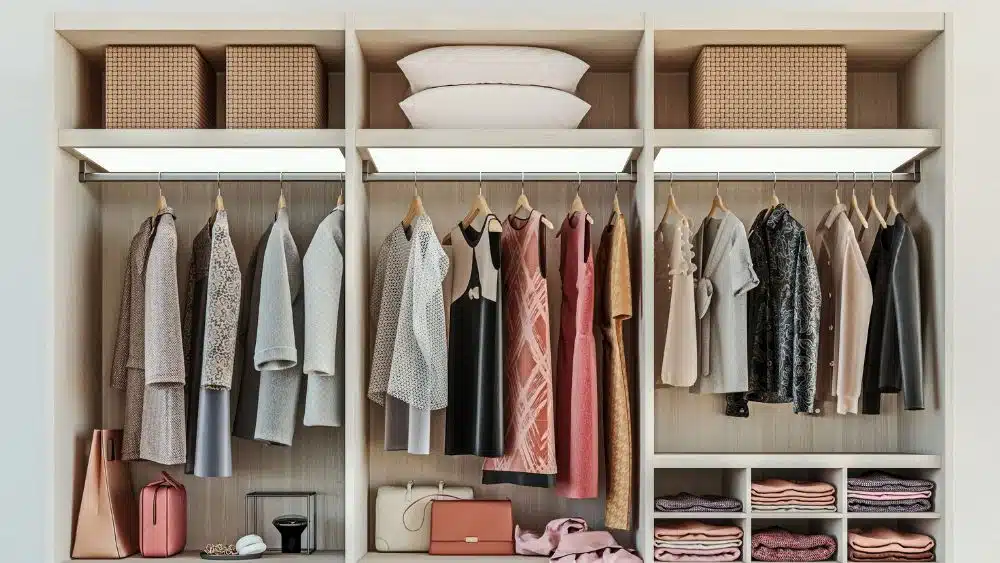Ever feel like you go into your closet and can’t find a single thing you actually want to wear? You’re not alone. Luckily, having the right closet system makes getting ready—and staying organized—so much easier.
So, what kind of system are you really looking for? The best ones work in two ways: They maintain order and optimize all the usable space. This means a closet system incorporates organizational tools like hanging rods, shelves, bins, drawers, cubbies, and more to accommodate your wardrobe needs.
Typically, closet systems can include other accessories like mirrors and lighting to really level up the tidy factor. When this system is put into place either by yourself or a professional, each and every item in your space will have a home, which will make getting ready a breeze. Essentially, the biggest perk is finding your much-loved sweater with ease.
Plus, there are a few other advantages: Peace of mind (because everything is neat), calmness and clarity (less clutter makes us feel better), easy access to seasonal wear (you may not have to rotate seasonal wardrobes), and durability (natural woods like cedar can help boost the longevity of your clothes). Closet systems are a total win-win in terms of handiness, useability, and money-saving opportunities.
Ready to dive into the world of closet systems? We put together a comprehensive guide for all things organization for you to check out. From types of closet systems and sizes to shoppable materials and more, get the full scoop.
Types of Closet Systems
There are loads of customizable options for closets on the market right now, and that might feel a little overwhelming. If the idea of just scrolling through the nearly endless offerings seems like too much to handle, don’t fret. We’ve got you covered.
Let’s look at the types of closet systems available.
Closet Islands

This stand-alone unit may also exist inside other closets, like configurable closets and walk-ins. More often than not, closet islands include drawers for storage and a few shelves for display (like shoes or bags).
Configurable

This is perhaps one of the most versatile options. Configurable closets can adapt to your needs and personal style with an assortment of items that’ll allow you to build a completely customizable closet: shoe drawers, bag cubbies, rods, shelves, rotating racks, et cetera.
Corner

Like the name says, corner systems are for corner units. This is a solid option for small spaces and unused areas that could be optimized to their full potential.
Reach-In

If you have a typical closet (aka, a reach-in style), where you often reach and grab an item, you’ll opt for this choice. Reach-ins include shelves and rods that can be stacked to create your preferred organization system.
Starter Kit

A standard collection of rods and shelves that you can configure in multiple ways to end up with a storage system to your liking.
Walk-In

Have a roomy, walk-in closet? This is just the ticket. This configuration is meant to be installed and includes a bevy of pieces to streamline the system (think drawers, shelves, rods, cubbies).
Walk-in Tower

Similar to the option above, walk-in towers encompass bookcase-like styles where the storage goes vertically in the space (AKA, free-standing towers or rolling carts and shelves). This may be a good option for walk-in spaces that are on the cozy side.
Closet System Sizes and Materials
Naturally, these closet systems come in a range of sizes so they can be customized for your new home. Typically, standard reach-in closets are 6 feet wide and 24 inches deep, so a starter or reach-in kit is most likely sized to those specs. Walk-ins can vary in size and width (usually beginning at 7 feet wide, and 6 feet deep), so you may be in the market for more specialty-built solutions.
Now, let’s talk about materials. These can make a world difference when it comes to durability and organization. The most reliable materials for your space? Solid wood, manufactured wood, and wire/metal. But don’t be afraid to mix things up for a unique design that’s within your budget.
Closet System Mounts
How are closet systems installed? In general, there are two ways, the closet is either free-standing, built-in, or wall-mounted.
So, what’s the difference? Simply put, freestanding systems use existing exterior frames (usually metal) to hold rods, shelves, and even drawers. Built-ins and wall-mounted, on the other hand, require permanent installation and are designed for specific storage needs.
Closet System Features
Across types of closet systems, there are a few features you’ll find available. These include rods, adjustable shelving, drawers, modular pieces (can be free-standing), cubbies, islands, soft-close drawers (no slamming here!), and doors. As always, widths and heights can be adjusted, and hardware and colors are totally customizable based on your aesthetic!

Stephanie Valente is a Content Director and Editor in Brooklyn, NY. She’s previously held writing and social media positions at Barkbox, Men’s Journal, and currently works at a full-service advertising agency. She’s a self-confessed home and design enthusiast. Stephanie is an award-winning poet and fiction writer. When she’s offline, you can find her taking a yoga class, running, hanging out with her rescue dog Pepper. Find her on stephanievalente.com.
 Best Tiny Home Builders in New Mexico
Best Tiny Home Builders in New Mexico